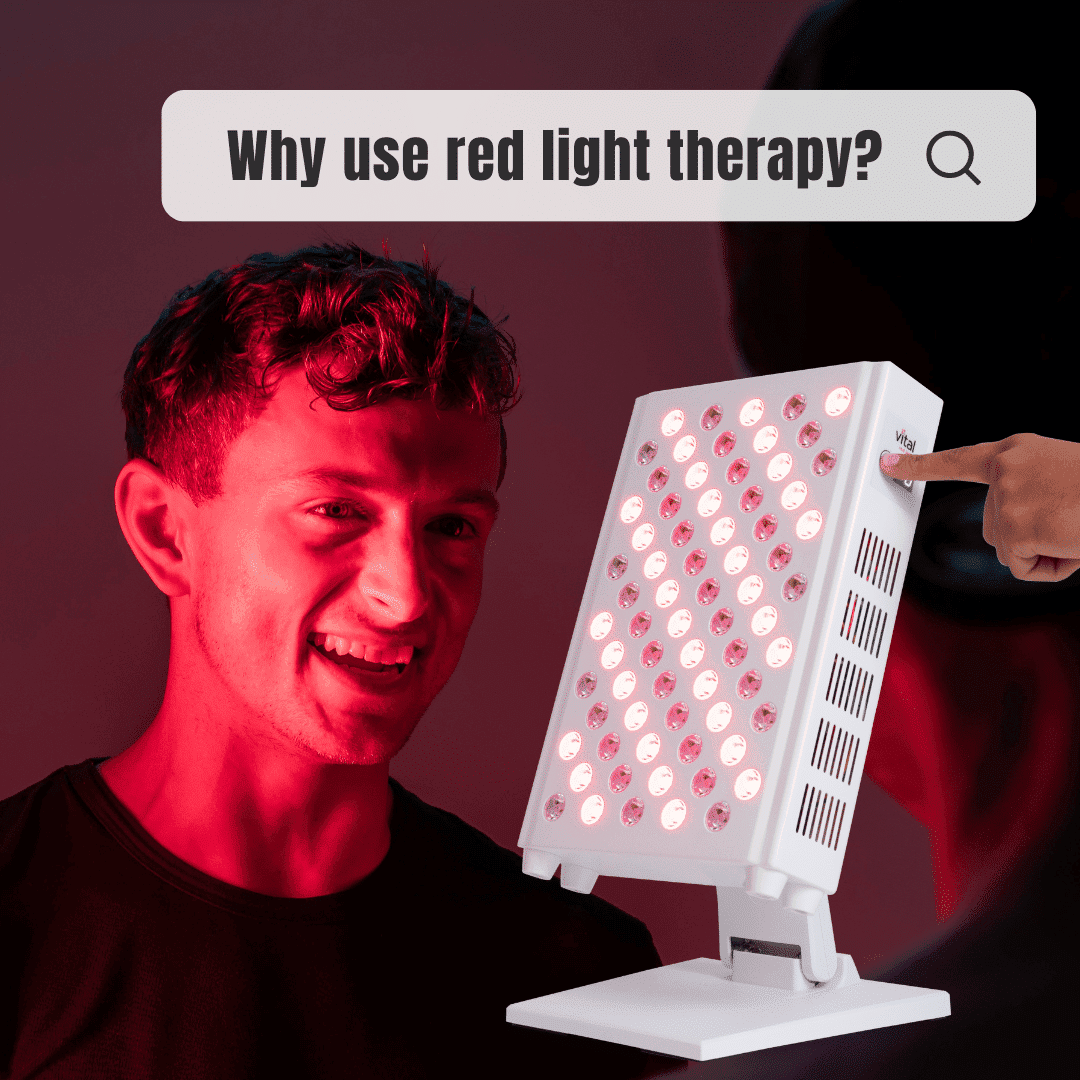- Jake Kreuz
- May 26, 2022
- Verified
The Real Science Behind Using Red Light Therapy to Increase Testosterone
You’ve seen the memes, read the articles, maybe even heard from a friend, or recently saw for yourself on Tucker Carlson — “Red light your balls for higher testosterone,” or as Carlson refers to it, “testicle tanning.” And, naturally, you have questions. In this article, we will answer all your top questions on RLT for testosterone.

Introduction
You’ve seen the memes, read the articles, maybe even heard from a friend, or recently saw for yourself on Tucker Carlson — “Red light your balls for higher testosterone,” or as Carlson refers to it, “testicle tanning.” And, naturally, you have questions.
Red light therapy may be something that you’ve heard about from your girlfriend, wife, or people like Tony Robbins or Ben Greenfield. This modality of body therapy is going mainstream thanks to athletes in the UFC, NFL, PGA, and on Olympic teams all using light therapy devices as a part of their training, recovery, and health routines. There is a reason that all the experts have been using this technology for decades — since NASA first discovered the technology in the 1980s while sending astronauts to space. [1] Since then, red light has been studied in over 450 clinical trials.
If you are a man who is struggling with low energy, stamina, brain fog, or other symptoms of low testosterone, or are simply looking to elevate your health routine, continue reading to see what the science says about red light therapy and the best way to use it to achieve certain health goals.
Setting the stage: the testosterone epidemic in America.
In the past decade, it has become increasingly clear that testosterone plays a major role in male health and vitality.
Testosterone is the main sex hormone in males and is responsible for all kinds of things, including: [2]
- Regulating sex drive
- Developing the penis and testes
- Voice deepening during puberty
- Fat distribution
- Muscle size and strength
- Bone growth and strength
- Sperm production
- Red blood cell production
The amount of testosterone that each man produces varies greatly, but it is known that, across the board, as men age, testosterone production naturally declines — we know this to be a fact. And a drop in testosterone can lead to a number of different issues, such as: [3]
- Reduction in body and facial hair
- Decrease in muscle mass
- Low libido
- Reduced sperm count
- Impotence
- Small testicles
- Increased breast size
- Hot flashes
- Depression
- Irritability
- Brittle bones
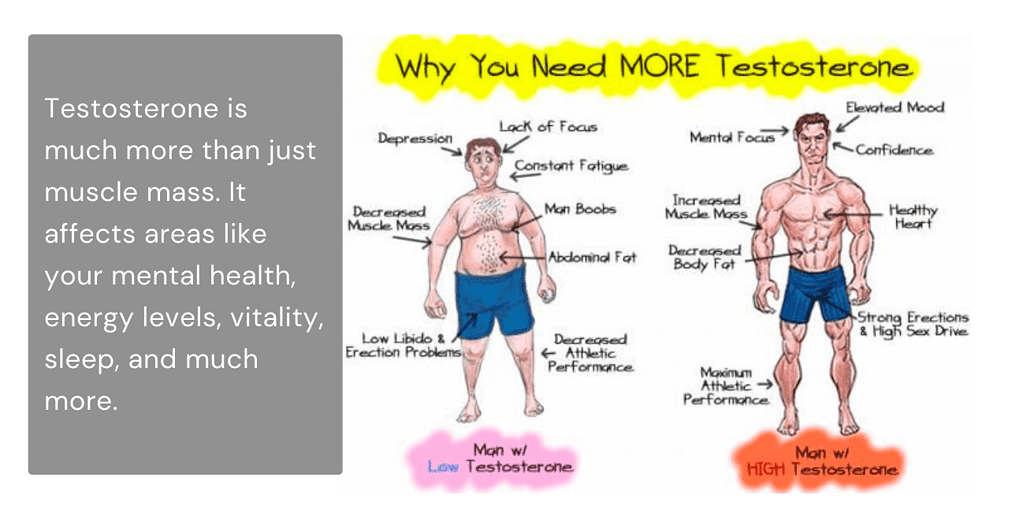
Why is this such an issue?
While some of these things are to be expected as you get older, the real problem we are facing today is the acceleration of American men’s decline in testosterone as well as the ages of men, particularly young men, that this is occurring in.
Looking at the numbers, you will see the acceleration (pictured above).
The average man over the age of 30 experiences a decrease in his natural testosterone production by 1-2% per year. In other words, the average 65-year-old American man in 2004 (the last year the study covered) had about 17% less testosterone than his counterpart in 1987 [4].
Some other data about testosterone:
- Recent studies have suggested that ~40% of men present a testosterone deficiency to their primary care provider. [5]
- Men as young as 24 are experiencing rapid declines in testosterone. [5]
- Another study found that men with lower testosterone levels were at a higher chance of dying from the coronavirus. [6]
- According to Healthline, around 4% of men under 60 have low testosterone levels, while 11% of men over 60 years old have low levels of this important hormone. [4]
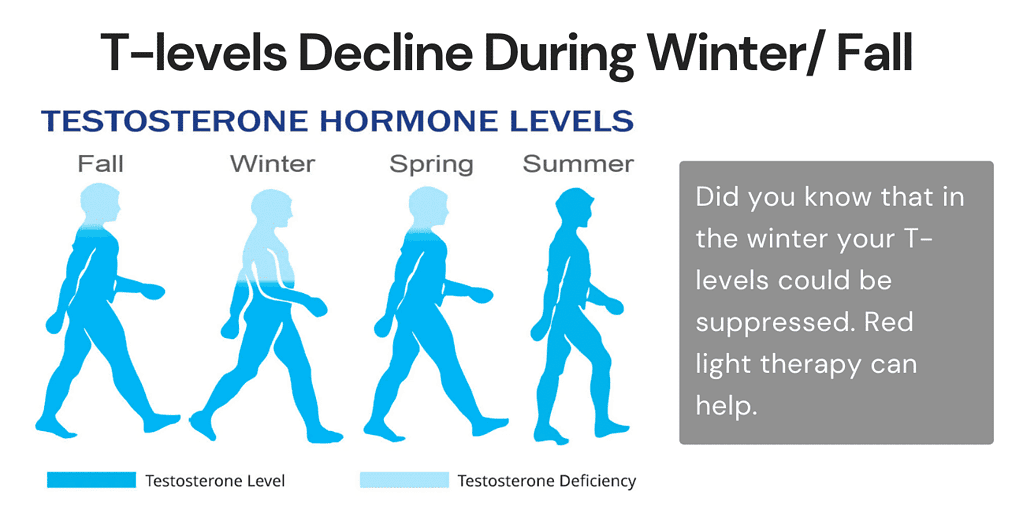
What causes testosterone levels to drop?
There are a number of different factors that may lead to low testosterone in men.
One of the biggest is age. As men get older, their testosterone levels tend to decrease. Men might also have low testosterone levels if they’ve been losing weight or have a history of chronic illness. Additionally, certain medications or treatments might affect testosterone levels. For example, radiation therapy can reduce testosterone levels while taking steroids might increase them.
What are some reasons for the drop in testosterone levels?
Studies have shown that some men experience a testosterone decline as they get older due to age-related hypogonadism, which is caused by a drop in the function of both the testicular and hypothalamic-pituitary. [7]
Other research has found that testosterone levels decrease with age due to illness and general health deterioration. [8]
Top reasons for low testosterone.
However, age is far from the only reason that you may find your T levels below optimal levels. Here are additional reasons why a decline in testosterone may be happening:
- Our modern lifestyle: Modern life, the pandemic, and an artificial lifestyle are the main culprits. Although the exact cause is not clear, there seem to be some major culprits.
- Obesity: It is well known that being overweight leads to reduced testosterone. This is partially because fat cells begin to convert free testosterone to estrogen.
- Low levels of vitamin D: Not enough vitamin D increases your likelihood of low testosterone, as well as chronic disease.
- Endocrine disruptors: Every year, 3,000 new materials in plastics, chemicals, and manufacturing are introduced with very little regulatory oversight. These chemicals and materials have the power to disrupt the production, transport, and release of natural hormones including testosterone. [9]
- Other reasons for low-T.
- Stress
- Lack of sleep
- Health conditions, such as diabetes or obesity
- Medication side effects
- Genetics
- Injury to the testicles
- Tumors in the pituitary gland or hypothalamus (areas of the brain that control hormones)
What are the symptoms of low testosterone?
For men today, the depressing reality is that many are struggling to maintain not just normal, but minimally healthy levels of this life-enhancing hormone.
Men as young as 24 years old are experiencing rapid declines in testosterone production, which leads to a drop in libido, hair loss, fatigue, brain fog, the inability to gain muscle (or lose weight), and depression [5].
Here’s what low testosterone looks and feels like in the body:
- Low libido, possibly even impotence
- Low sperm count, potentially even infertility
- Decreased testicle size
- Reduced muscle mass
- Decrease in facial and body hair (hair loss)
- Breast tissue development
- Weak or brittle bones
- Parchment-like appearance of the skin
- Lowered concentration and brain fog
- Irritability, anxiety, and depression
How to maintain healthy testosterone levels
Though this all may feel pretty daunting, don’t worry – there is hope. It is possible for you to put in the time and effort to keep your testosterone levels in an optimal place.
A man’s hormones will naturally decline with age, which can lead to a loss of muscle mass, increased fat storage, weaker bones, and lower energy levels. However, you don’t have to accept that as your fate – you have the ability to get your body in a place where it can produce the right amount of testosterone, even as you age.
To maintain healthy testosterone levels, men need to be physically active and eat well. Adequate amounts of sleep are also important.
The body can produce testosterone on its own, but it sometimes needs a natural boost to help keep levels within a healthy range. Testosterone supplementation can be beneficial for men experiencing low testosterone levels or symptoms associated with low T.
But, we have an even better option than supplements – red light therapy. Many men incorporate red light therapy into their lives in order to increase testosterone levels naturally.
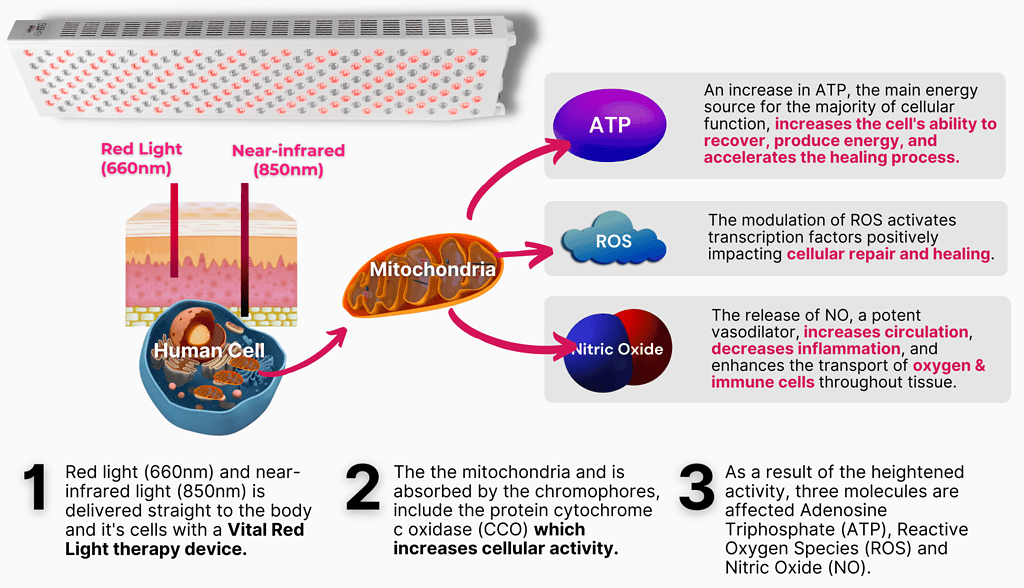
What is red light therapy?
The term “red light therapy” refers to the process of taking two very specific wavelengths of light that are naturally produced by the sun. Red light (at 660 nanometers) and near-infrared light (at 850 nanometers) are both directed straight to your body and its cells.
These two wavelengths of light are very unique in that they have been proven to have a “biological response” in your body — specifically in each one of your cells.
How does red light therapy work?
Red light therapy has been shown to enhance testosterone secretion, by way of increasing ATP production in the Leydig cells of the testis. [10] ATP refers to an energy-carrying molecule that exists in the cells of every living thing, and it works to provide energy to fuel cellular processes of all kinds.
Using Red Light therapy for sexual health.
Research on sexual health applications of red-light therapy is relatively minimal in men, and basically nonexistent for women. However, a key study in humans suggests red light therapy can increase testosterone levels and sexual satisfaction. [11]
In addition to that, multiple studies in animals suggest red light therapy might influence Leydig cells — the body’s sperm producers, which live in the testicles.
Though testosterone is produced mainly in the testicles (Leydig cells) as well as the ovaries, it’s also produced in smaller amounts in the adrenal glands. Within these organs, cholesterol is converted to testosterone through a process called steroidogenesis. Recent research on mitochondrial function in Leydig cells demonstrates that “mitochondria must be energized, polarized, and actively respiring to support Leydig cell steroidogenesis.”
Studies suggest that red and near-infrared light wavelengths can stimulate the Leydig cells – the cells responsible for producing testosterone in the testicles naturally. The enhanced energy production can help naturally increase the testosterone hormone.
Think of it this way: the red light, “wakes up” the dormant cells that have been lazy because they see no reason to be turned “on” thanks to the constant low-level stress in your life. Though the stress levels are low, they are still there and affect your cells.
Additional studies such as a 2016 study University of Siena, one of Italy’s law and medicine universities, suggest that light therapy interacts with the pineal gland in the brain, which plays a major role in human reproduction. [10]
Red light therapy and testosterone production
As we’ve seen above, irradiation with red and near-infrared light optimizes the use of oxygen within the mitochondria to synthesize energy in the form of ATP. Thus, red light therapy can help facilitate steroidogenesis and, ultimately, healthy testosterone production. [12]
Red light therapy has the potential to influence the body’s sperm producers which live in the testicles. Clinical studies have shown that red light therapy can increase sperm efficiency and influence levels of sexual satisfaction in both men and women. Additionally, various studies have shown major improvements in male fertility and sperm mobility that can affect sexual performance. In all of these clinical studies, red light therapy has been shown to be safe on male genitals with no DNA damage.
Red light therapy can also help improve the quality of life of people with low testosterone by mitigating some of the symptoms. In fact, some of the many proven benefits of red light therapy include:
- Increased muscle mass and strength
- Better athletic performance
- Improved cognitive function
- Improved mood
- Better sleep
- Hair growth
Conclusion: Using Red light at-home for testosterone
Around the age of 30, male testosterone levels naturally start to decrease and for some men, this begins even earlier.
Men who want to see a natural and safe increase in their sex drives, sexual satisfaction, fertility, and physical performance may first look to therapies or other pharmacological approaches. Unfortunately, those can come with a slew of side effects that may open up Pandora’s box of problems.
But what if we told you that you can get the increase in your sex drive, sexual satisfaction, fertility, and athletic performance you’re looking for in an easy and natural way that comes packed with additional benefits rather than negative side effects? You can reap those benefits by incorporating red light therapy into their lives.
Red and near-infrared wavelengths have been proven to stimulate photoreceptor proteins in the testes, thus causing higher testosterone production. Studies have also shown the potential for low-level light therapy and its effect on the pineal gland in the brain, which bears a significant impact on reproduction and overall well-being.
Red or infrared light from an LED source (600-950nm) has been studied for use on the male gonads and studied in men looking to raise their testosterone levels naturally. The most studied form of red light therapy is from LEDs and lasers. Visible red (600-700nm) LEDs seem to be optimal in increasing testosterone levels naturally.
Vital Red Light devices all offer the visible red wavelength you need to naturally boost your T-levels where you need them to be. Choose from our Vital Elite, an at-home panel that is big enough to reap benefits for your whole body in one sitting, our Vital Pro which is ideal for targeted red light therapy, and our Vital Charge – meant for on-the-go red light therapy needs.
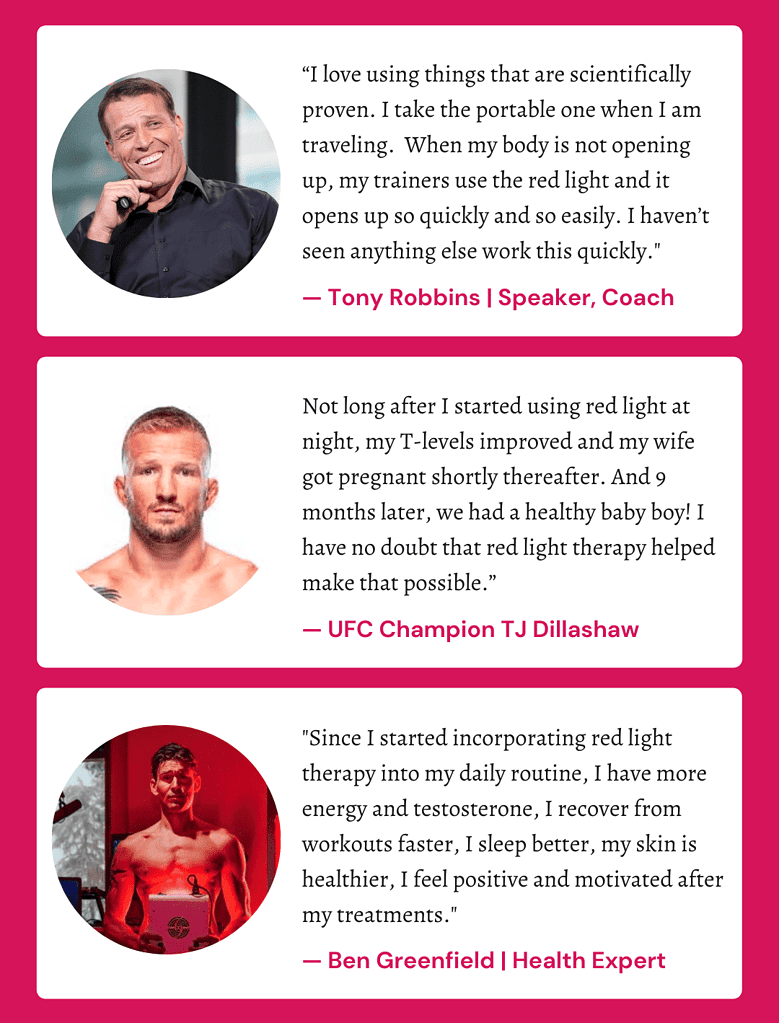
Citations:
[1] Cotler, Howard B. “A NASA discovery has current applications in orthopaedics.” Current orthopaedic practice vol. 26,1 (2015): 72-74. doi:10.1097/BCO, https://www.ncbi.nlm.nih.gov/pmc/articles/PMC4272231/
[2] https://www.nih.gov/news-events/nih-research-matters/understanding-how-testosterone-affects-men
[3] https://www.health.harvard.edu/medications/testosterone–what-it-does-and-doesnt-do
[4] Healthline, Gotter A and Rogers G, MD. Low Testosterone in Men. Healthline. Jul 2016.
[5] https://www.nih.gov/news-events/nih-research-matters/understanding-how-testosterone-affects-men
[6] European College of Neuropsychopharmacology (ECNP). “Lack of interest in sex successfully treated by exposure to bright light.” ScienceDaily. ScienceDaily, 18 September 2016.
[7] Golan, Ron et al. “Age-related testosterone decline is due to waning of both testicular and hypothalamic-pituitary function.” https://www.ncbi.nlm.nih.gov/pmc/articles/PMC4816459/
[8] Stanworth, Roger D, and T Hugh Jones. “Testosterone for the aging male; current evidence and recommended practice.” Clinical interventions in aging vol. 3,1 (2008): 25-44. doi:10.2147/cia.s190, https://www.ncbi.nlm.nih.gov/pmc/articles/PMC2544367/
[9] Jeng, Hueiwang Anna. “Exposure to endocrine disrupting chemicals and male reproductive health.” Frontiers in public health vol. 2 55. 5 Jun. 2014,https://www.ncbi.nlm.nih.gov/pmc/articles/PMC4046332/
[10] Vladimirovich Moskvin S., Ivanovich Apolikhin O. Effectiveness of low level laser therapy for treating male infertility. Biomedicine (Taipei). 2018 June; 8(2):7, https://www.ncbi.nlm.nih.gov/pmc/articles/PMC5992952/
[11] Ban Frangez H., Frangez I., Verdenik I., Jansa V., Virant Klun I. Photobiomodulation with light-emitting diodes improves sperm motility in men with asthenozoospermia. Laser in Medical Science, 2015 Jan;30(1):235-40., https://pubmed.ncbi.nlm.nih.gov/25204851/
[12] Salman Yazdi, R., Bakhshi, S., Jannat Alipoor, F. et al. Effect of 830-nm diode laser irradiation on human sperm motility. Lasers Med Sci. (2014) 29: 97, https://pubmed.ncbi.nlm.nih.gov/23407899/
Share
Download our FREE E-Book
Want to learn more? Download our official Red Light Therapy guide with over 1,214 clinical references on the power of Red Light Therapy.
Do you want to learn more?
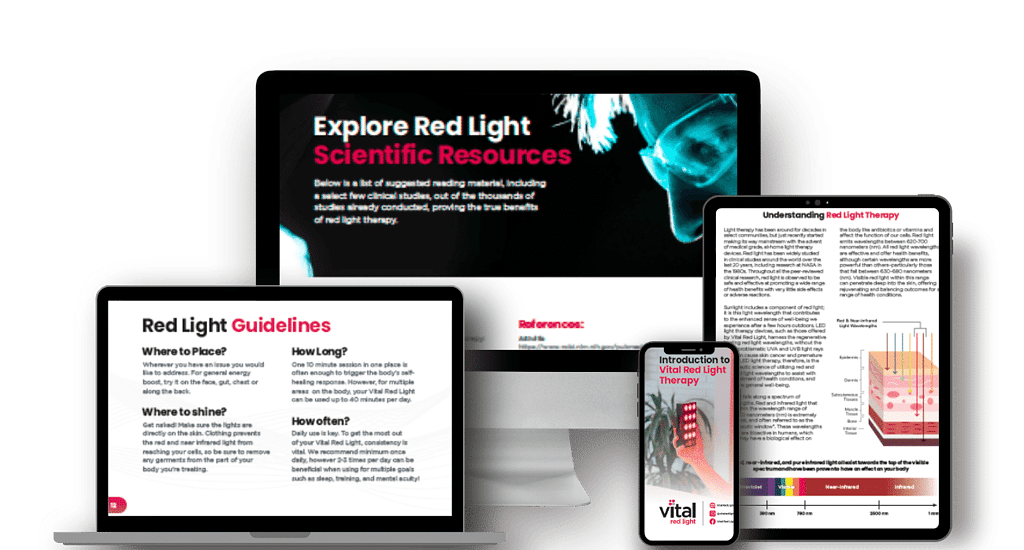
Explore Related Articles
Red Light Therapy Morning Ritual
Why Use Red Light Therapy?
Red Light Therapy Benefits & How it Works

Explore Red Light Devices
Vital Pro is a targeted red and near-infrared LED light therapy device that improves skin health, promotes full-body wellness, and improves cellular health.




